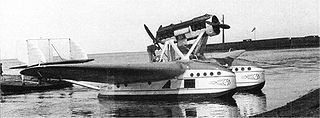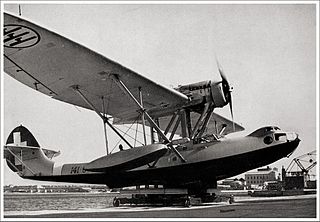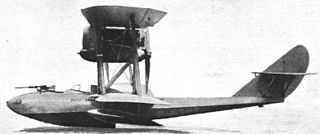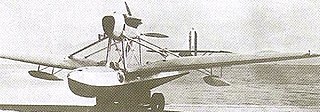| SM.78 | |
|---|---|
 | |
| Role | Bomber/reconnaissance flying boat |
| Manufacturer | Savoia-Marchetti |
| First flight | 1932 |
| Number built | 49 |
The Savoia-Marchetti SM.78 was an Italian bomber/reconnaissance biplane flying boat of the early 1930s.
| SM.78 | |
|---|---|
 | |
| Role | Bomber/reconnaissance flying boat |
| Manufacturer | Savoia-Marchetti |
| First flight | 1932 |
| Number built | 49 |
The Savoia-Marchetti SM.78 was an Italian bomber/reconnaissance biplane flying boat of the early 1930s.
The SM.78 first flew at the end of 1932, designed for the role of maritime reconnaissance-bomber. It was one of the many flying boats made by SIAI (Savoia-Marchetti), that in 1915 had started building foreign aircraft under licence, followed two years later by the first of its own designs.
The SM.78 was developed from the SM.62bis. The prototype, which carried the serial number MM222, made its first flight late in 1932 [1] and then transferred the next year to Vigna di Valle for evaluation. The SM.78 was the last biplane flying boat, built or used in large numbers by Italy; 49 were completed in all (32 by Piaggio and 17 by SIAI).
The SM.78 was a single-bay biplane. It had a long and slim aft fuselage, with a tall welded steel fin and a wooden horizontal tail mounted centrally. The lower hull had two steps, to aid take-off from the sea.
This aircraft evolved from the SM.62bis, retaining practically the same unmodified wings, tail and fuselage, but with a different model of Handley Page flaps.
The hull/fuselage had poplar frames, and longerons made of ash. The plywood-skinned hull had a double-layered bottom, with an external layer of cedar, while the flanks were made from orthogonally arranged laminates of cedar. The fabric-covered wings had spruce longerons and poplar ribs, utilising the low-weight and high-strength characteristics of these woods, and were painted to render them impermeable to water. Twin stabilising floats were mounted at mid-wing.
While the pilot and co-pilot were seated side-by-side in an enclosed cockpit in the prototype, this was replaced by an open cockpit in the production model. [1] A crew position mounting a 7.7 mm (0.303 in) Lewis Gun was situated in the nose, which also contained two cameras. This position was manned by the co-pilot when necessary, the aircraft having a three-man crew. A second, enclosed turret was fitted in the dorsal position, also armed with a 7.7 mm (.303 in) Lewis gun, manned by the gunner/radio operator, who was also provided with an R.A.350 transmitter and an A.R.4 receiver. The aircraft was not fitted with an intercom, but the two pilots could communicate with the nose position using a "pneumatic message" system in which messages were passed through a tube. The forward machine gun had 564 rounds of ammunition in 12 magazines, while the aft machine gun had 470 in 10 magazines. Bombs were carried in a bomb bay within the lower wing, near to the fuselage. The weapon-load was 700 kg (1,540 lb) maximum. Typical combinations were: 2 × 250 kg (550 lb) and 2 × 100 kg (220 lb) bombs, 6 × 100 kg (220 lb) bombs, 4 × 70 kg (150 lb) depth charges, or 6 × 12 kg (26 lb) training bombs. Smoke generators could also be mounted on the inner hardpoints. A "Jozza" bombsight was located on the right in the cockpit, behind a glazed window.
The aircraft was powered by a single Isotta Fraschini Asso 750 W18 engine, generating 671 kW (900 hp) at takeoff, arranged in a steel structure mounted between the two wings, driving a four-bladed propeller with variable pitch that could be set before takeoff. This, and the much refined hull of this aircraft bestowed a good performance for the time. A CO2 fire extinguisher was mounted by the engine. A total of 2,200 L (580 US gal) of fuel could be carried in six unarmoured duralumin fuselage tanks, two aft, two central and two forward.
The SM.78 was built between 1932 and 1935, with only 16 by SIAI and 32 from Piaggio. It equipped the 141° Squadriglia, based at La Spezia, the 144° based at Livorno, the 182° at Nisida and the 189° at Syracuse. It continued to serve until 1938, [1] being replaced by the CANT Z.501, a monoplane design with superior performance. Some aircraft remained in service during the early phase of World War II, performing in an air-sea-rescue capacity. Spain, which already operated SM.62s, tried unsuccessfully to acquire a licence to build the SM.78, leaving Italy as the only operator.
Data fromItalian Civil and Military Aircraft 1930–1945 [2]
General characteristics
Performance
Armament
Related development
Related lists

The Savoia-Marchetti S.55 was a double-hulled flying boat produced in Italy, beginning in 1924. Shortly after its introduction, it began setting records for speed, payload, altitude and range.

The Savoia-Marchetti SM.81 Pipistrello was the first three-engine bomber/transport aircraft serving in the Italian Regia Aeronautica. When it appeared in 1935, it represented a real step ahead in Italian military aviation: it was fast, well armed and had a long range. It proved effective during the war with Ethiopia and the Spanish Civil War. Despite being too slow to remain competitive as a bomber in the later years of World War II, it was one of the most flexible, reliable and important aircraft of the Regia Aeronautica from 1935 to 1944, and adapted to second-line duties in a wide range of tasks.

The CANT Z.501 Gabbiano was a high-wing central-hull flying boat, with two outboard floats. It was powered by a single engine installed in the middle of the main-plane and had a crew of 4–5 men. It served with the Italian Regia Aeronautica during World War II, as a reconnaissance aeroplane. During its debut in 1934, it set a world distance record. It was obsolete by 1940, but was still used throughout World War II, suffering many losses. A few remained in service until 1949.

The Savoia-Marchetti SM.85 was an Italian monoplane dive bomber and ground-attack aircraft that served in small numbers in the Regia Aeronautica at the beginning of World War II. They were soon replaced in service by the Junkers Ju 87.

The SIAI S.8 was an Italian 1910s two-seat reconnaissance flying boat.

The Caproni Ca.135 was an Italian medium bomber designed in Bergamo in Italy by Cesare Pallavicino. It flew for the first time in 1935, and entered service with the Peruvian Air Force in 1937, and with the Regia Aeronautica in January 1938.

The Savoia-Marchetti SM.84, not to be confused with the Savoia-Marchetti S.84 airliner prototype, was an Italian bomber aircraft of World War II. It was designed by Savoia-Marchetti as a replacement for its successful SM.79, and shared its three-engine layout. Despite entering service with the Regia Aeronautica in 1941, it was retired from service before the SM.79 and never fully replaced it.

The Savoia-Marchetti SM.91 was a two-seat, twin-engined, Italian heavy fighter prototype, designed to compete in a 1942 revision to a long-range fighter-bomber contract offered by the Regia Aeronautica to Italian aircraft companies in 1938. The original 1938 specification yielded the Savoia-Marchetti SM.88, which the SM.91 was largely based on.

The Savoia-Marchetti SM.62 was an Italian single-engine maritime patrol flying boat produced from 1926. It served with the Regia Aeronautica and with a number of foreign users, and was produced in Spain and the Soviet Union. Some of the Spanish aircraft were still in service during the Spanish Civil War.

The Breda Ba.201 was an Italian dive bomber designed during World War II, that never entered production.

The FBA Type H was a French reconnaissance flying boat produced in large numbers in France and Italy during World War I by Franco-British Aviation.

The Savoia-Marchetti S.59 was a 1920s Italian reconnaissance/bomber flying boat designed and built by Savoia-Marchetti for the Regia Aeronautica.

The Savoia-Marchetti S.57 was an Italian single-engine biplane flying boat intended for aerial reconnaissance, built by Savoia-Marchetti for Regia Aeronautica after World War I.
The Macchi M.8 was an Italian reconnaissance/bomber flying boat designed by Alessandro Tonini and built by Macchi. It was used by the Italian Naval Aviation and was later flown by crews from the United States Navy.

The SIAI S.58 or Savoia-Marchetti S.M.58 was an Italian flying boat fighter prototype of the 1920s designed and manufactured by SIAI.

The SIAI S.67 or Savoia Marchetti SM.67 was an Italian flying boat fighter of the early 1930s designed and manufactured by SIAI.

The Caproni Ca.95 was a large, three engine, long range, heavy bomber prototype built in Italy in 1929. It could carry a 1,600 kg (3,500 lb) bomb load and had three defensive gun positions. Only one was built.

The Savoia-Marchetti S.63 was a single hull development of the Italian Savoia-Marchetti S.55 flying boat. It first flew as a bomber in 1927 but was rapidly converted into an airliner. The only S.63 built served with an Italian airline.
The Macchi M.C.77 was a reconnaissance bomber flying boat built by Macchi in the thirties and remained at the prototype stage.
The Caproni Ca.66 and Caproni Ca.67 were Italian night bomber aircraft designed to re-equip the post-World War I Regia Aeronautica.